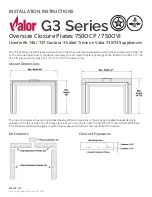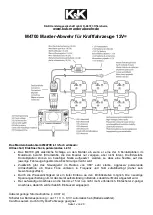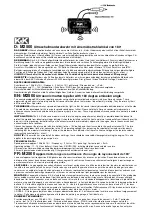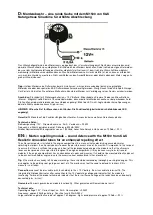04
05
SAFETY INSPECTIONS AND OBSOLESCENCE
Before Every Use:
Check the soles of the boots to confirm that they are in good condition and attached securely to the boots. Check the linings to confirm that they are
not ripped or torn. Check uppers to confirm that they are not cut, torn, cracked or worn. Check the hook and loop fastener material to confirm that
it is not filled with debris and may be engaged properly. Check the buckles and buckle straps to confirm they are not broken or damaged and can be
engaged correctly. Check the zippers to confirm that they operate properly and are not broken. Protective footwear that is improperly fastened cannot
protect the user. If the protective footwear or any parts of them become worn, replace the footwear immediately.
In the Event of an Impact or Accident:
In the event of an impact or accident, the key elements of the protective footwear may become compromised and the protective footwear may no
longer provide the limited protection against the forces described in the “Use Restrictions and Limitations” section above, and the “Performance”
and “Protection Limitations” sections below. The damage may not be visible to the naked eye. In all cases of impact or accident, replace the boots.
Replacement Retrograde Boots can be purchased at Icon® retail locations.
2 Year Rule:
In general, lightweight PPE such as the Retrograde Boot should be replaced at least every 2 years even if the PPE has not suffered any damage.
Damage may be present and may not always be identified by a simple visual inspection.
SAFETY WARNINGS
USE
Selecting the Correct Size:
In order to ensure you choose the correct size Retrograde Boot please see the table below
PPE Position and Fit:
For PPE to offer the maximum protection possible PPE must be placed on the areas to be protected and PPE must cover the protected areas
effectively. If the protective features are already incorporated into the PPE, then to be positioned correctly, the PPE must be the correct size. In all
cases, the proper equipment has been supplied to keep this PPE firmly in contact with the body.
Footwear:
Protective footwear fit is very important. The fit of different protective footwear styles varies due to differences in design and construction. Only use
protective footwear that fits properly. Any protective footwear that does not fit properly should not be used. Be sure that the protective footwear fits
snugly but not too tightly. Confirm that heel lift is minimal. Check to confirm adequate room in the toe box.
Wearing Instructions and Adjustment:
Repeat for each boot: Release the instep buckle strap by lifting the strap off of the buckle post and sliding the buckle strap out of the buckle. Open
the upper of the boot by pulling on the adjustment tab on the outside of the shin releasing the hook and loop material. Unzip zipper on rear of boot
by pulling zipper pull down. Pull the heel pull/gusset rearward so that the foot may be inserted. Insert foot, pulling the boot on. Slide foot all the way
down in the boot. Confirm boot fit. Boot should feel snug on foot but not too tight. Foot should be the same length as the boot without being too much
shorter or too much longer than the boot. Check to confirm that the heel pull/gusset is entirely inside the boot and does not interfere with the zipper.
Zip boot closed by pulling zipper pull up. Confirm that no pant, sock, heel pull/gusset or other material is caught in the zipper preventing it from
engaging completely. Reengage the instep buckle by passing the buckle strap through the buckle and pressing one of the holes in the buckle strap
onto the buckle post. Engage the adjustment tab on the outside of the calf by first pulling it rearward and then pressing the adjustment tab against
the calf, reengaging the hook and loop fastener material. Confirm that no pant, sock, or other material is caught in the adjustment tab hook and loop
fastener material preventing it from engaging completely. The fit should not impair circulation of the foot. If the boot is too tight at the instep or calf,
fit may be adjusted by releasing the buckle strap and adjustment tab as above and repositioning and reengaging them. Be sure that the boot is snug
enough to stay on the foot but not so tight that it impairs blood circulation or the range of motion of your foot. Check to confirm that wearing these
boots does not reduce your ability to operate the motorcycle controls.
For maximum protection and safety the protective footwear should not cause any discomfort and should not reduce the rider’s freedom of movement
or restrict the reach to, or operation of, the motorcycle controls while in a normal riding position. If you are unable to find a proper fit in this protective
footwear style, please try another CE certified protective footwear style.
MEN’S SIZES
EU
41
42
43
43.5
44
44.5
45
45.5
46
47
48.5
US
8
8.5
9
9.5
10
10.5
11
11.5
12
13
14
UK
7.5
8
8.5
9
9.5
10
10.5
11
11.5
12.5
13.5
PERFORMANCE
Retrograde Boots have undergone EC Type Examination to assure compliance with Directive 89/686/EEC. They have additionally been examined and
tested to assure their compliance with the appropriate technical Standard.
European standard EN 13634:2015 includes two performance levels in terms of the protection afforded. The degree of risk or hazard that a
motorcyclist will face is closely linked to the type of riding and the nature of the accident. Within standard EN 13634:2015 ‘Level 1’ performance
is deemed as the minimum level required in order for the footwear to provide useful protection in an accident, and offers footwear with an optimum
comfort level to suit all riding types. Where riders feel that their riding style or sport exposes them to an increased accident risk ‘Level 2’ has been
provided which offers increased performance – however it is likely that this additional level of protection has an increased penalty for the weight and
comfort, so may not be acceptable to all riders.
RetrogradeBootCEManual.indd 4-5
6/3/2016 3:40:11 PM


















